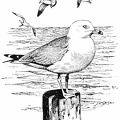Steganopus tricolor
Phalaropes are unique. Unlike most birds, the female is more colorful, does most of the courting, leaves nest building, incubating and rearing of young to the long-suffering male. Her lone contribution to the rearing of the family is laying eggs. She does deserve some credit, however, for she remains in the area and will join the male in circling overhead when the nest is disturbed, both uttering a sort of nasal, trumpet-like toot.
Wilson’s Phalarope is not only the largest phalarope, but prefers inland marshes, while the Red Phalarope and Northern Phalarope spend more time at sea. In breeding plumage, the female shows a distinctive black line down the side of the neck, starting in front of the eye and blending into a chestnut wash on the shoulders. Under parts and throat are white, wings gray with a gray line extending thru the cinnamon buff of the back. The male is grayer with a cinnamon wash on the neck. In fall, both birds show dark wings, white rump patch and light plumage. The long, needle-like bill and the whirling motion when swimming are good clues to identification in any season. When feeding in shallow water, these birds are active, always in a hurry and running from place to place.
- Author
- The Project Gutenberg EBook of Introduction to Our Bird Friends, Volume 2, by Lenwood Ballard Carson
Published 1957 - Posted on
- Wednesday 8 July 2020
- Dimensions
- 611*669
- Tags
- Birds
- Albums
- Visits
- 767
- Downloads
- 30
 Download Photo
Download Photo





